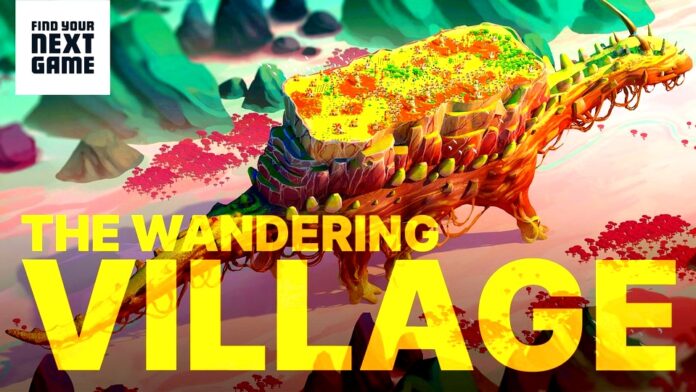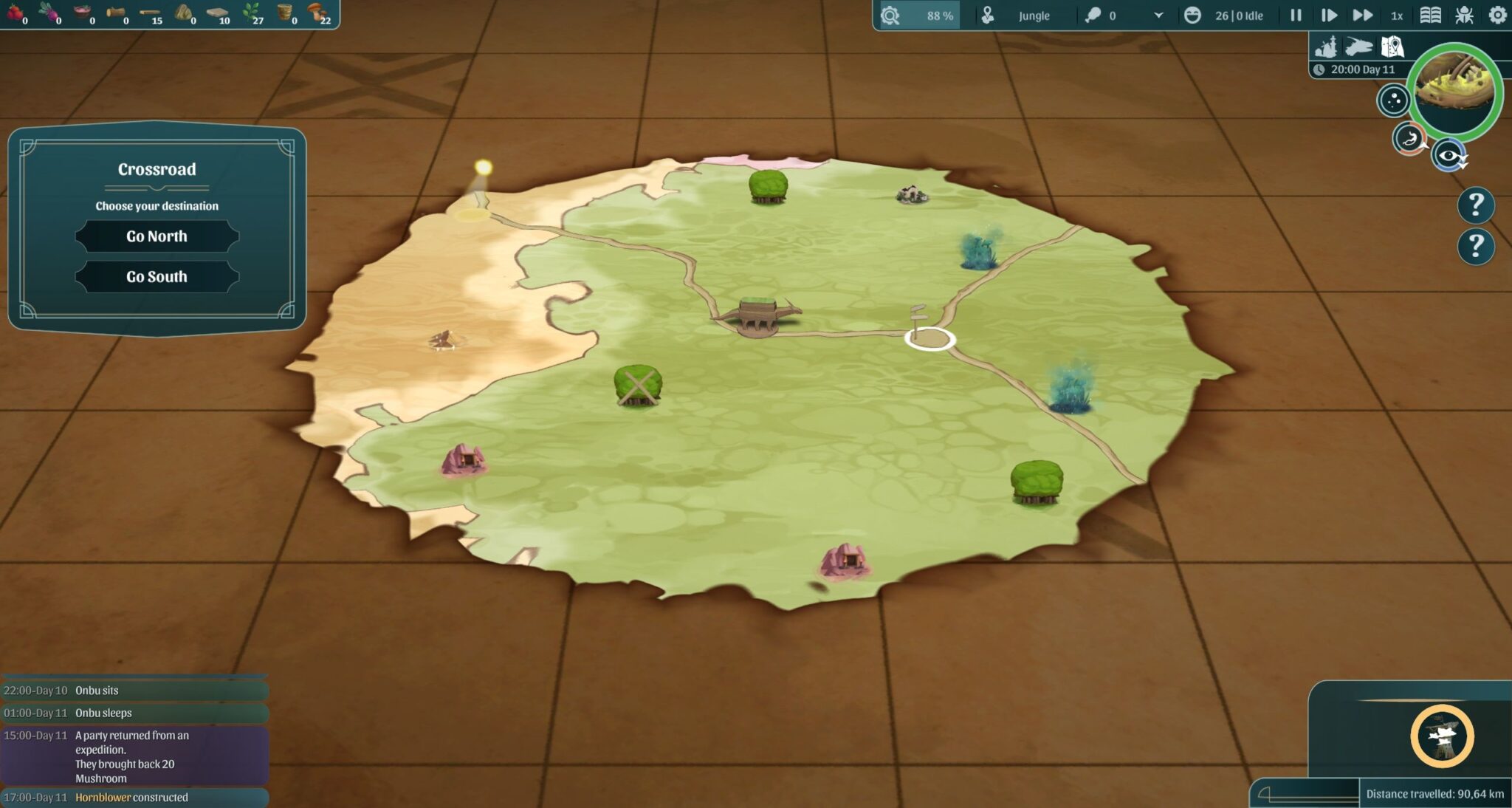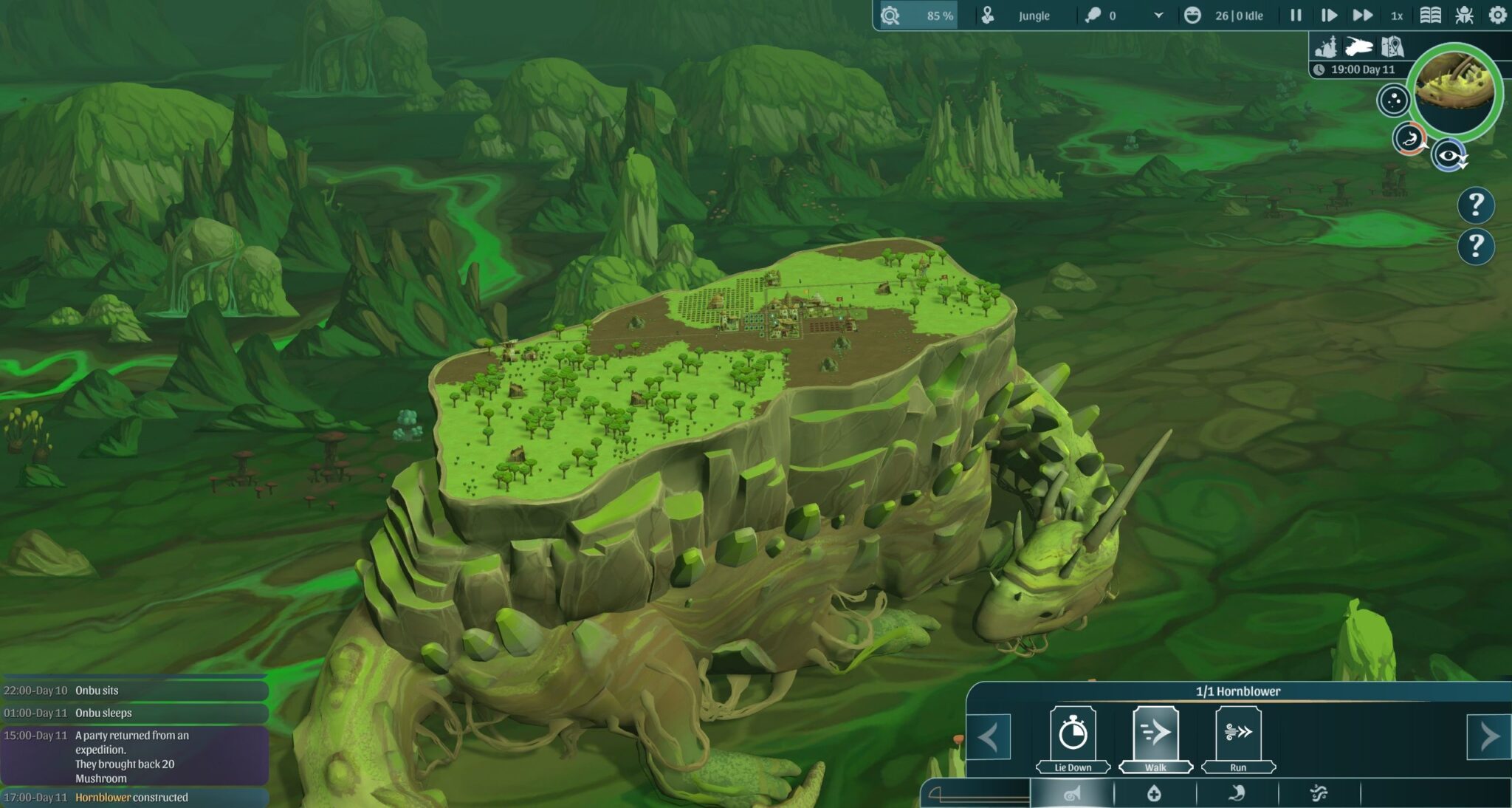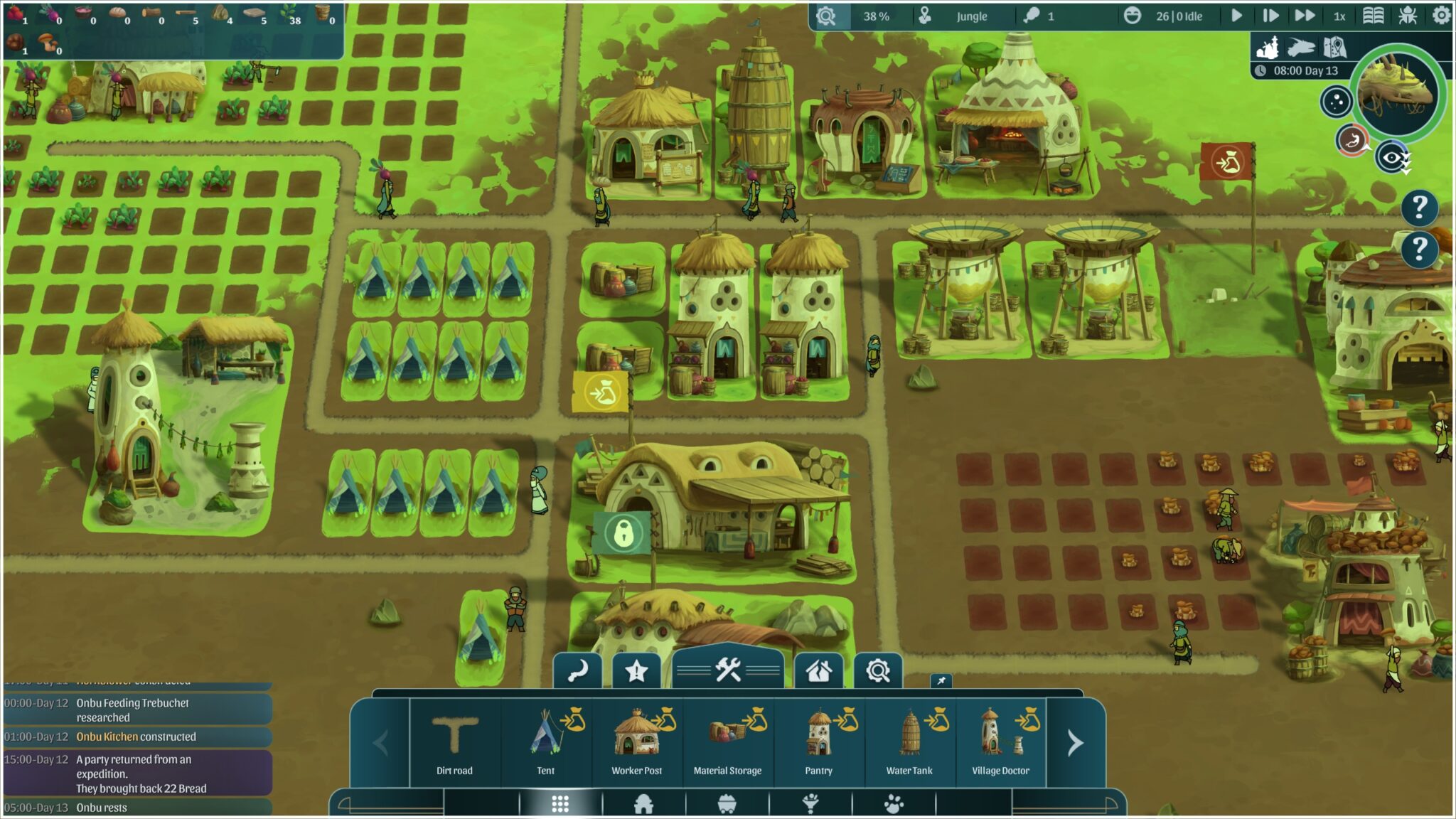Whoever thinks building strategy is told through has never built a settlement on the back of a gigantic, living animal!
Zoom in, zoom out, zoom in, zoom out, zoom in … Actually, I should have erected the first buildings of my settlement long ago, but in the (Free Demo of The Wandering Village) I just can’t stop turning the mouse wheel for minutes!
Somehow it’s no wonder: in what other building game am I allowed to zoom from the world map over a gigantic monster to the berry bush growing on its back? Exactly!
The Wandering Village is set in a post-apocalyptic world that is becoming increasingly uninhabitable due to mysterious poisonous plants. A small group of survivors therefore seek shelter on the back of a gigantic wandering creature they call Onbu. My job is to ensure their survival as much as that of Onbu.
From this intriguing basic idea, Swiss indie studio Stray Fawn (Niche, Nimbatus) makes an even more intriguing game that wonderfully mixes classic Settlers-style building tinkering with just the right pinch of Frostpunk Survival and FTL Roguelike, without any of these ingredients dominating.
Instead, even before the start of the Early Access phase in the summer, they result in an equally harmonious and astonishingly comprehensive building game whole, for which I currently even leave Anno 1800 to the left.
What makes The Wandering Village special?
Initial excitement about zooming in and out gives way after only a few minutes to the realisation that this is not just a visual gimmick, but actually an important gameplay feature.
Because The Wandering Village consists of three components, even if the classic building strategy clearly dominates:
1. settlement building and administration: On Onbu’s back I place houses, farms, carpenters and warehouses, but also more unusual buildings such as a feeding trebuchet, which sends species-appropriate giant cattle food down Onbu’s gullet.
The Annoholic in me rejoices when it comes to the space puzzle: transport routes play an important role, farms require different soil conditions, and a food cat desk naturally belongs near the mouth.
Due to the small space and the limited number of inhabitants, I have to micromanage a surprising amount, which is pleasantly reminiscent of the first Settlers games. Paths accelerate the speed of my carriers and workers, and I have to prioritise processes again and again because the conditions and challenges of my settlement are constantly changing.
Because the building site on Onbu’s back naturally always remains the same, The Wandering Village, unlike an Anno, goes less into breadth and more into depth during the course of the campaign. I get more and more options to get the most out of the limited building space.
2. roguelike exploration: As I build, Onbu trudges through a procedurally generated game world. If I have built a hornblower tower, I can even give him commands, such as which direction to take at the next turn. In addition, as in Frostpunk, I send expeditions into randomly generated forests, mines or settlement ruins to cart back valuable resources or even new survivors.
The world also consists of different biomes that have a massive influence on my settlement. If you don’t diligently collect water and cultivate crops in the temperate jungles, you will experience a hungry miracle in the desert regions. And the plants mentioned at the beginning keep spreading poisonous spores on Onbu’s back, which I should take care of as soon as possible.
3 Pokémon Survival: Onbu is not just a fancy animated place for my settlement, but a sentient being whose well-being I have to take care of just as much as that of the survivors. It needs food as well as sleep, and if it dies, I automatically lose the game.
The further I expand my settlement, the more opportunities I have to interact with Onbu. And the further I advance into the post-apocalyptic world, the greater the dangers become. In this way, The Wandering Village very cleverly avoids the routine trap of most other building games, which become increasingly easy once I have built everything.
What do we like?
The visuals: The Wandering Village may look rather simple in still images, but in motion it quickly unfolds an enchanting cartoon charm reminiscent of the films by Studio Ghibli, which even a manga sceptic like me can hardly resist.
Above all, everything seems wonderfully alive and organic: in the background, the landscape of the respective biome passes by, in the foreground I follow the detail-loving hustle and bustle of my subjects who, like in The Settlers, fell trees, harvest turnips and transport every resource comprehensibly from A to B to C. Only a few non-animated production buildings are missing.
Only a few non-animated production buildings diminish the “fun to watch” effect. Stray Fawn wants to improve this in the course of the Early Access phase.
The depth of the game: In the beginning, I only juggle four resources, two handfuls of building types and 16 survivors in The Wandering Village. And all this in a jungle that is as green as it is fertile.
But the further Onbu progresses, the more I understand how well one cog fits into the other. The trick: I always have more tasks than workers available. Moreover, trees and berries on Onbu’s back grow back very slowly.
If you just cut down and build up wildly, you will have problems in the first desert region at the latest. Instead, I have to prioritise cleverly and adapt my strategy flexibly to the respective environmental conditions.
And then there is the research tree with 30 additional buildings that expand my scope of action to the same extent that I have to face new challenges.
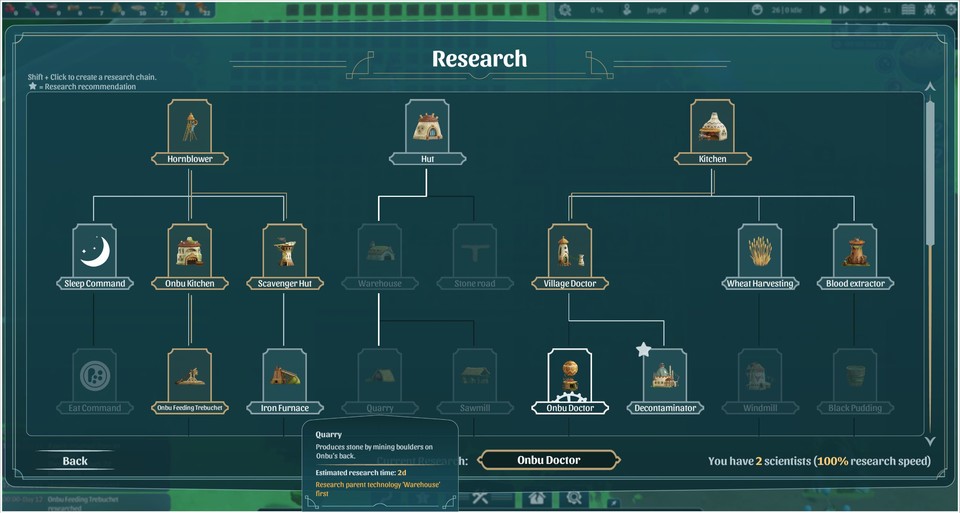
The clean implementation: The demo occupies around two to four hours per playthrough, depending on how you play, but already looks more polished than many indie building games at release.
Clearly legible icons tell me precisely what problems a settler or building has. I can speed up and slow down the action at any time and even give orders in pause mode, unlike in Anno 1800, so that there is never any stress despite the survival theme.
Download the free demo
You can get to The Wandering Village demo, which is around two to four hours long, via the (Steam product page of The Wandering Village). The actual download button is a bit hidden, you can find it in the right info column.
The rest of the operation also runs smoothly, except for a few small things, which is why the development studio can “only” concentrate on balancing and adding more content during the planned one-year Early Access phase.
The jungle, desert and mountain regions are to be supplemented by a water and a ruin biome. Flying merchants, tameable birds and additional story elements are also on the update list. However, the actual core of The Wandering Village is already working perfectly.
What is still unclear?
The storytelling: What caused the environmental disaster? Where did my nomadic people come from? What kind of being is Onbu, and are there more like him? Or is he even a she? It speaks for the atmosphere of The Wandering Village that so many questions run through my head while playing.
But it would be great if the roguelike campaign could answer them. Apart from a short intro and a few tutorial text boxes, there are no story elements at all, but they will be added in the course of the Early Access phase.
On the one hand, by distributing lore objects in the game world, on the other hand via a dedicated story mode. However, according to studio founder Philomena Schwab, it is still unclear what this will look like.
The balancing: The basic interplay of a lot of building strategy, a bit of roguelike and a pinch of survival already works well, but Stray Fawn still has to solve the big balancing questions.
How do they avoid frustrating dead ends in the course of the campaign, in case I’ve made a mistake? How fairly do the random elements affect the (so far only) difficulty level? And most importantly, how much do I want to do another playthrough if I have to experience the death of my much-loved Onbus?
For it is already clear: A campaign in The Wandering Village will last significantly longer than those of fellow roguelikes like FTL, Hades or Slay the Spire. On the one hand, this speaks for scope and game depth, but on the other hand, it massively increases the risk of frustration in case of late failure.
This can even spoil the mood of a zoom fetishist like me, even if I will still be zooming in and out a lot until then. Zoom in, zoom out, zoom in, zoom out, zoom in…
Editorial conclusion
The Wandering Village may not be on many people’s radar yet, but it could actually be the biggest build-up game surprise since Frostpunk. The idea with the wandering giant creature as a building area is simply ingenious and so much more than just a visual gimmick.
On the one hand, it increases the identification with my settlement: it should not only work efficiently and look nice, but also ensure the survival of my nomadic tribe and the dearest Onbus!
On the other hand, it solves the classic routine problem of many construction games: Here, my settlement literally wanders through a constantly changing game world. What was efficient a few minutes ago can suddenly endanger the survival of my tribe.
The already very rounded state of The Wandering Village also makes me confident that the Early Access phase here is not just pure marketing, but can really be used to polish a diamond in the rough. How much it will ultimately shine is, of course, still written in the stars. But anyone with a heart for intelligent building games should at least try out the free demo and keep an eye on the wandering village.

